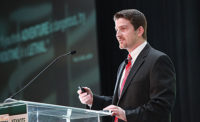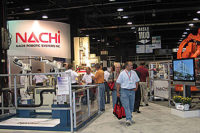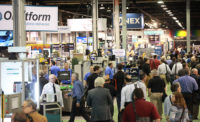Nearly 3,000 manufacturing professionals attended the launch of The Assembly Show in October at the Donald E. Stephens Convention Center in Rosemont, IL.
Some 150 exhibitors, occupying nearly 38,000 square feet, displayed the latest assembly technologies, including adhesives, conveyors, dispensers, fasteners, parts feeders, plastics joining equipment, power tools, presses, riveters, robots, software, test and inspection equipment, wire processors, and workstations. In addition, the show hosted some 14 systems integrators, including Arthur G. Russell Co. Inc., ATC Automation, the Doerfer Cos., Edgewater Automation, Fusion Systems, Invotec Engineering, Isthmus Engineering & Manufacturing, and ixmation North America. Several contract manufacturers, including Arc-tronics Inc. and Siemens Manufacturing Co. Inc., also exhibited at the show.
“We listened to the industry and worked closely with our charter exhibitors to run an event exclusively focused on assembly technology and equipment, and the results were overwhelmingly positive,” says Tom Esposito, publisher of ASSEMBLY. “In recent years, there have been many assembly trade shows that have just been a small segment of larger events. It is obvious that our industry can sustain a standalone event. We thank our exhibitors, our sponsors and our attendees for supporting us in this new endeavor.”
Many exhibitors deemed the show a success. “The quality and quantity of leads generated from this show has been the best for us,” says Floyd Dickson, vice president of Tutelar Technologies. “We were speaking to assembly people—our target audience. No other show does this for us. Overall a great show for Tutelar, and we look forward to an ongoing relationship.”
“The ASSEMBLY Show has been fantastic. We knew this was a first-year event, and we have been very surprised. The results have far exceeded our expectations,” adds Dan McKeirnan, president of eFlex Systems. “The quality of the people that came to our booth, the questions we are being asked, and the leads that were being generated have been second to none. We’ve never had this much positive experience at a trade show environment.”
For the exhibitors, the event went so well that more than 75 percent have already renewed for the 2014 show, which will take place Oct. 28-30 back in Rosemont.
With the show floor dedicated exclusively to assembly technology, manufacturing professionals also thought the show was a success.
“At the Assembly Show, I don’t have to search through a lot of exhibits that don’t interest me to find what I am looking for,” reports a manufacturing engineer from Caterpillar Inc. “I am interested in everything here, and it is all together.”
Three-quarters of the attendees came from seven states: Illinois, Wisconsin, Michigan, Indiana, Ohio, Minnesota and Iowa. They represented every major industry covered by ASSEMBLY: automotive, aerospace, appliances and electrical equipment, medical devices, machinery, electronics, fabricated metal products, consumer products—even shoes.
Attendees represented such major manufacturers as A.O. Smith, Applied Materials Inc., ATK, Becton Dickinson, Bodine Electric Co., The Boeing Co., Briggs & Stratton, Broadwind Energy, Cisco Systems Inc., Cree Lighting, Deere & Co., Faurecia, Flextronics International, Ford Motor Co., The Kohler Co., Motorola, Schneider Electric, Whirlpool Corp. and Yazaki North America.
Not Just Exhibits
Besides the exhibits, The Assembly Show offered two keynote speakers and a dozen educational sessions that were held in theaters set up on the show floor. Both keynotes and many of the educational sessions were broadcast live via the Internet. The presentations were also recorded and are now available at www.theassemblyshow.com.
Educational sessions were given by Panasonic Assembly Tools, Nordson EFD, Dymax Corp., Desoutter Industrial Tools, Henkel Corp., eFlex Systems, and Czuba Enterprises, as well as industry associations, including the Chicagoland Chamber of Commerce, Alliance for Illinois Manufacturing, The Illinois Science and Technology Coalition, and the Illinois Manufacturing Excellence Center.
The keynote speakers shared their insights on the current and future state of U.S. manufacturing.
Daniel Meckstroth, Ph.D., vice president and chief economist of the Manufacturers Alliance for Productivity & Innovation, delivered the opening day keynote address to a packed audience. Meckstroth provided detailed analysis on the prospects for manufacturing growth in the U.S. and global economies.
“Manufacturing took a huge hit during the recession relative to the rest of the economy,” says Meckstroth. “However, we bounced back faster because we fell deeper. Now, the growth rates of manufacturing and the general economy are converging.
“This year, we expect manufacturing to grow 2.2 percent, and we expect the general economy to grow 1.6 percent. Next year, we’re looking for 3.2 percent growth in manufacturing and 2.8 percent growth in the general economy. And in 2015, we expect a ramp-up in business investment that will lead to 4.1 percent growth in manufacturing, and 3.4 percent growth in the general economy. So manufacturing is still growing faster than the general economy, but not that much faster.”
During his address, Meckstroth grouped manufacturing into three categories—consumer goods, business goods and materials—and assessed each group’s growth prospects.
Consumer-related manufacturing is growing. “The housing supply chain is ramping up, with strong growth predicted for furniture manufacturing, wood products manufacturing and HVAC manufacturing,” says Meckstroth. “The food sector is growing at a steady, moderate rate. There will be some growth in motor vehicle sales, but the rate of growth will be much slower than it has been over the past couple of years.
“All totaled, we expect consumer-driven manufacturing to increase 3 percent this year, 3 percent next year and 4 percent in 2014.”
The prospects for business-related manufacturing are less certain. “The No. 1 factor in business investment is profitability, and corporate profits are at record levels,” Meckstroth points out. “Firms are swimming in cash. Interest rates are the lowest they’ve been in a lifetime. And capacity utilization is relatively high. We should be having an investment boom right now. But we’re not. And that’s because of all the uncertainty in Washington, all the uncertainty about the slow-growing economy, and concerns about the recessions in Japan and Europe.
“The good news is, durable goods orders are greater than shipments, so the backlog is building for equipment.”
Meckstroth predicts growth in aerospace production to be very strong during the next two years. Construction machinery, metal-working machinery and industrial machinery should also ramp up, though not at “boom” levels.
Although materials manufacturing is basically driven by consumer spending, Meckstroth expects only moderate growth in the production of things like paper, steel and chemicals.
The second keynote address was presented by Michael F. Molnar, chief manufacturing officer of the National Institute of Standards and Technology. Molnar discussed the newly created National Network for Manufacturing Innovation. By bridging the gap between the private sector and basic research conducted at universities and federal labs, the network hopes to reverse the trend in which high-tech products, such as lithium-ion batteries and solar panels, are invented here in the United States but manufactured elsewhere.
In addition to the educational program, ASSEMBLY partnered with Manufacturing Revival Radio to produce a series of live broadcasts from the exhibit hall. Hosts Todd Schnick and Todd Youngblood interviewed 24 leading industry experts about new assembly technology and manufacturing trends.
The interviews were subsequently turned into podcasts, which can be found on our Web site at www.assemblymag.com/media/podcasts/2710. Each segment lasts about 10 minutes and is packed with useful information.
The interviews cover a wide variety of topics, including electronic work instructions; robot end-effectors; assembly presses; cordless tools; error-proof fastening; leak and flow testing; torque audits; orbital forming; robotic dispensing and soldering; retaining compounds; vision systems; manufacturing software; piezoelectric jet valves; mechatronics; and wire processing.











